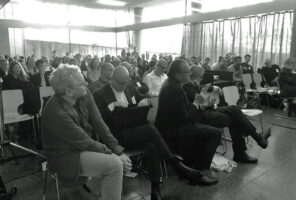Construct
Published as Timmermansoog column on: website Architectenweb, February 2020
 ‘Ah, well, that’s how you effectively kill the architect’s profession!’ At a German congress, a young architect had claimed that you had to go and ask how to build on the construction site and an established colleague felt compelled to put him in his place – rather daring in this age of unbridled listening-and-connecting.
‘Ah, well, that’s how you effectively kill the architect’s profession!’ At a German congress, a young architect had claimed that you had to go and ask how to build on the construction site and an established colleague felt compelled to put him in his place – rather daring in this age of unbridled listening-and-connecting.
The congress was about the extent to which construction belongs to the core of architecture. The word ‘construction’ has a broad meaning in German. My father, who regarded his Dutch architectural construction handbooks (written by the once illustrious Jellema) as Bibles, used the word ‘construct’ in the same way as the Germans, similar to the way we talk today about detail.

It proved that the peers gathered had a firm belief in architectural construction as an all-determining expertise. The way in which that faith was supported varied considerably. Roughly speaking, there were two groups. The first regarded construction as a performative aspect of their profession: to them it served the smooth realisation of buildings. One might characterise this as the construction of the building site. On the other hand was the construction of the art school, in which is sought the imaginative potential of an architectural construct. The first position was argued to lead to buildability, simplicity and order; the second to trial and error, complexity and signature.
The two different camps explained concepts such as innovation and experiment in almost opposite ways. The resulting linguistic confusion was as entertaining as it was instructive. One would wish that all architects would reflect on their work this seriously.
The S-word was barely used – and yet the conversation at the conference was about nothing but sustainability. It reminded me of some special constructions designed by an architect who was not present. A few years ago, in a tiny attic studio, I saw a bathroom floor made from a single slab of natural stone. The gutters, profiles and drains were accurately integrated. It must have been quite a hassle to lift the plate into the attic. It seemed as if the bathroom completely coincided with the intense colour and texture of its floor. Even more convincing was the guest-house by the same architect. The rooms were sparsely furnished and covered with wallpaper that tuned the spaces with heavy, saturated colours. The paper-hanger had been a wizard. The motifs matched exactly. At the top, a ribbon finished the cutting edge of the wallpaper. I found a remarkable white marble fireplace. A box-shaped beam lay on two cylinders. The two columns had spiralling veins that turned in opposite directions. In the simplest possible way it suggested an architrave upon two columns.
The intensity of these constructions transcends the German controversy. The builder of this beauty, Hans Kollhoff, again demonstrated the serious and deliberate way in which he constructs. There is something essential that sits in between his authorship and the perfect execution by the paperhanger or the stone master: the responsible choice of material. Of course one should not kill that profession. If we really have to extract building materials from the earth, then let us do so with utmost care – or so Kollhoff’s constructions teach us.
Text edition English translation by Charles Rattray